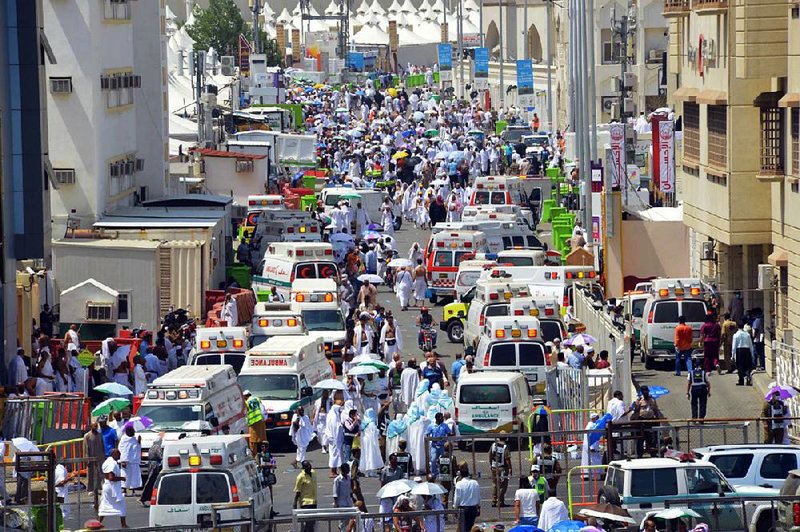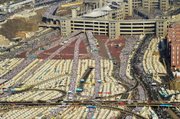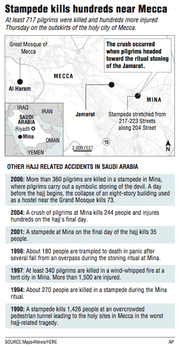MINA, Saudi Arabia -- Two giant waves of Muslim pilgrims collided at an intersection Thursday near a holy site in Saudi Arabia, and more than 700 people were crushed and trampled to death in the worst disaster at the hajj in a quarter-century.
"People were climbing over one another just to breathe," said Abdullah Lotfy of Egypt. "It was like a wave. You go forward and suddenly you go back."
The hajj, which drew 2 million people from more than 180 countries this year, is a huge logistical challenge for Saudi Arabia. The kingdom has spent billions of dollars to accommodate the growing number of pilgrims and maintain safety and security at Islam's holy cities of Mecca and Medina for the annual event.
Saudi authorities began an investigation, said Interior Ministry spokesman Maj. Gen. Mansour al-Turki, adding that initial reports showed two crowds coming from opposing directions converged about 9 a.m. at an intersection in Mina, on the outskirts of Mecca, when the pushing and shoving started.
"Unfortunately, these incidents happen in a moment," al-Turki said at a news conference.
The Saudi health minister, Khalid al-Falih, said in a statement that the stampede may have been "caused by the movement of some pilgrims who didn't follow the guidelines and instructions issued by the responsible authorities."
But four survivors questioned how those officials managing the flow of people could allow two big crowds going in different directions to intersect on two streets packed with pilgrims.
"What happened was more than they were ready for," Lotfy, 44, said.
As of late Thursday, the Saudi civil defense directorate reported on Twitter the death toll at 719, but that was expected to rise as bodies continued to be counted and sent to the morgue. At least 863 people were injured, the directorate said, and two medical centers had been opened in Mina to treat the injured.
"We ask God to grant the martyrs his mercy," the directorate tweeted.
More than 4,000 emergency workers were sent to the scene, and hundreds of people were taken to four hospitals.
Bodies were still lying on the ground more than 10 hours after the crush and ensuing stampede in Mina, a large valley containing 160,000 tents for accommodations about 3 miles from Mecca.
One crowd had just finished a ritual -- the Stoning of the Devil, a re-enactment of a story from the Koran involving the Prophet Abraham, in which pilgrims throw pebbles at three stone columns -- when it ran into another wave of people heading to perform the rite.
Sudanese pilgrim Mohammed Awad, 36, and his 56-year-old father were separated when people began pushing and shoving. Awad said he tried to get out of the crush of bodies for about 30 minutes and eventually climbed over a gate with others. It took him an hour before he could look for his father, who was under at least 10 bodies -- but still alive.
"You can't count how many bodies there were. They were stacked high," Awad said.
Amateur video on social media showed scores of bodies -- many still dressed in the simple terry cloth garments worn during hajj -- lying among crushed wheelchairs and water bottles on a sunbaked street. One video showed a heap of men lying atop one another as workers in fluorescent yellow vests worked to separate the living from the dead and to rescue any survivors.
Cellphones and cameras are prohibited from the main sanctuaries, but cameras may be used in the surrounding areas.
Helicopters circled Mina throughout the day, ferrying the injured to hospitals, while military police blocked the streets where the deaths took place.
Saudi Arabia takes great pride in its role as the caretaker of Islam's holiest sites and host to millions of Muslims who must perform the hajj at least once in their lives. Signs posted across Mecca tell pilgrims that Saudi Arabia is honored to serve them, and the Saudi king takes the title of "Custodian of the Two Holy Mosques" in reference to the sites in Mecca and Medina.
About 100,000 security officers were deployed to manage the crowds and provide security for this year's hajj, with 5,000 closed-circuit TV cameras throughout Mecca and Medina.
Over the years, the Saudi government has expanded Mecca's Grand Mosque that houses Islam's most sacred site, the cube-shaped Kaaba. The government also uses sophisticated face-counting technology installed at a multistory structure in Mina known as the Jamarat Bridge, near where the disaster occurred. The wide ramps and technology are designed to ease the pressure of the crowds and prevent pilgrims from being trampled.
Unlike the wide ramps leading to Jamarat, the streets connecting the tents in Mina are narrow. The street where the accident took place is about 36 feet wide, with tall gates to the left and right. Behind the gates are the tents of hajj tour groups, organized by nationality.
King Salman expressed his condolences and pledged a speedy investigation. He said he gave instructions for a review of "all existing plans and arrangements ... to improve the level of organization and management of the movement" of the pilgrims.
Blame from Iran
Saudi Arabia's regional rival Iran immediately blamed the kingdom for mismanagement in the disaster.
At least 131 Iranians died, according to the official IRNA news agency, and Iran's Supreme Leader Ayatollah Khamenei said Saudi Arabia "is obliged to admit its responsibility."
"Unfortunately, they have not been attending to our injured individuals in their hospitals the way they should," Qazi Askar, the representative of Iran's supreme leader for hajj affairs, said in an interview with state television. "The point which makes one wonder is that they do not even let our rescue relief teams visit the site and attend to them, or go to hospitals to identify our injured ones. I don't know what kind of service this is for pilgrims."
It was the second major accident during this year's hajj season. On Sept. 11, a construction crane crashed down onto the Grand Mosque, killing 111 people and injuring more than 390. Authorities said high winds from a powerful storm caused the collapse and faulted the construction giant Saudi Binladin Group, which oversees construction at the mosque, for not following operating procedures.
Sami Angawi, who founded the government's Hajj Research Center in the 1970s and has studied the logistics of the hajj, said it is not enough for Saudi ministers and their deputies to meet a few times a year to oversee the planning and coordination of various agencies for the hajj.
"It is like a chain, and you don't know where the weak link will be," he said. "Each part of the hajj affects the other. Preparation needs to be year-round."
The disaster came as Muslims around the world marked the start of the Eid al-Adha holiday, a traditionally festive time in which livestock is slaughtered and its meat distributed to the poor.
The mood in Mina was somber, however, and many were stunned by the calamity instead of jubilant at completing the pilgrimage.
Ismail Hamba, 58, of Nigeria, said he was on his way to cast stones when he suddenly became dizzy and fell down.
"By the special grace of God ... a young man rescued me," he said at a small clinic at the site of the accident, adding that he doesn't know how he survived.
"It was terrible. It was really, really terrible," said Hamba, who was making his second hajj.
Thursday's accident was the worst since a similar incident in 2006 near the same site when more than 360 pilgrims were killed in a stampede.
The deadliest hajj-related accident was in 1990, when 1,426 pilgrims died in a stampede in an overcrowded pedestrian tunnel leading to holy sites in Mecca.
Even before Thursday's stampede, this year's pilgrimage season had been marred by mishaps. Last week, about 1,000 pilgrims from Asia had to leave their hotel because of a fire, which injured two Indonesians. This week, about 1,500 pilgrims were evacuated from a 15-story hotel in Mecca when a fire broke out on 11th floor. Four pilgrims from Yemen were hurt.
The latest accident is certain to touch many different countries, and condolences poured in from around the world. U.S. National Security Council spokesman Ned Price said the U.S. joins in mourning for "the tragic loss of these faithful pilgrims," while United Nations Secretary-General Ban Ki-moon was "deeply saddened" by the deaths, his spokesman said.
In the Pakistani city of Lahore, Sajida Arif said her father, Haji, was among the dead. "Before leaving for the hajj, he told me he had a wish to be buried in Mecca," she said.
Information for this article was contributed by Aya Batrawy, Adam Schreck, Sarah El Deeb in Beirut, Maram Mazen, Merrit Kennedy, Munir Ahmed and Nasser Karimi of The Associated Press and by Ben Hubbard, Mona Boshnaq, Kareem Fahim, Thomas Erdbrink and Christine Hauser of The New York Times.
A Section on 09/25/2015


